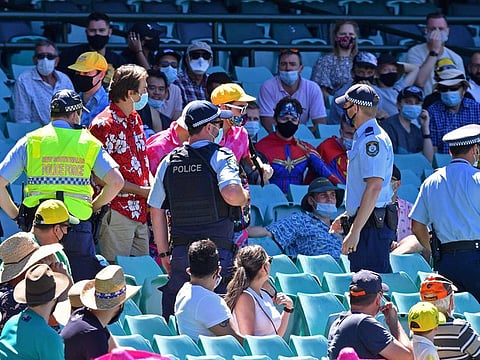'Not acceptable': Australia's long battle with racism in sport
Australian authorities are struggling to stamp out the problem

Sydney: The alleged racist abuse of Indian players by fans at the third Test in Sydney is just the latest in a litany of similar incidents to mar sport in Australia, with authorities struggling to stamp out the problem.
Cricket chiefs vowed tough action, including bans, fines and referral to police if spectators were proven to have hurled racist taunts after two incidents on separate days overshadowed the blockbuster clash.
But it remains an ongoing, albeit isolated, issue.
Fast bowlers Mohammed Siraj and Jasprit Bumrah were apparently targeted while they fielded near the boundary ropes of the Sydney Cricket Ground late Saturday, with reports that they were called "monkey", among other insults.
In a second incident, play was halted on Sunday when Siraj ran from the boundary toward the umpires, pointing into the crowd. It was not immediately clear what was said, but six men were ejected and investigations are under way.
Veteran Indian spinner Ravi Ashwin said it wasn't a new problem for visiting teams, claiming he had been on the end of "nasty" abuse across four tours to the country, with Sydney the worst.
"This has been a continual thing at Sydney, I have personally experienced it as well," he said.
"If I take myself back to my first tour in 2011-12, I had no clue about racial abuse and how you can be made to feel small in front of so many people.
"And the people actually laugh at you when you get abused, I had no idea what this was about.
Online trolls
"When I stood at the boundary line you wanted to stand another 10 yards in to keep yourself away from these things... this is definitely not acceptable."
The Australia team had formed a "barefoot circle" ahead of the four-Test series against the cricketing powerhouse to demonstrate opposition to racism and celebrate Aboriginal culture.
Cricket Australia strongly condemned the weekend incidents, as did deputy Prime Minister Michael McCormack, who said: "There is no place for racism in Australia. We are a tolerant country and the most successful multicultural nation in the world."
But it has been an issue in Australian sport stretching back decades, on and off the field.
Former Australian Test star Usman Khawaja has previously said he was abused so much growing up that he refused to support the national side, and claimed racism once even played a role in selections for the team.
Khawaja, who immigrated as a child, battled the odds to become Australia's first Pakistan-born national player, but it wasn't easy.
"Getting sledged by opposition players and their parents was the norm. Some of them said it just quietly enough for only me to hear," he wrote several years ago.
As he got older, he said Australia also grew up and "I started to understand that the minority of Australians who did treat me this way were just that, a minority".
Allrounder Dan Christian has also been a victim, mostly from online trolls, revealing last year he was targeted for speaking up about "casual racism" in cricket.
'It's definitely there'
One of just six Indigenous players to represent Australia at international level, he said it wasn't "as in-your-face as you might see elsewhere around the world" but that "it's definitely there".
Football has also been tarnished, with Brisbane Roar goalkeeper Jamie Young, who is of Sri Lankan and Scottish descent, racially abused by a disgruntled fan in 2018. The perpetrator was banned from future homes games.
Australia's most popular spectator sport, Aussie Rules, which is similar to Ireland's Gaelic football and has long featured Indigenous stars, has been one of the worst culprits, known for raucous crowds taunting players.
Such behaviour was in bygone days considered part and parcel of the game, but attitudes began changing in the 1990s.
One of the most powerful images associated with racism in Australian sport is of Indigenous St Kilda player Nicky Winmar, who in 1993 responded to abuse from Collingwood supporters by lifting his shirt while facing the crowd and pointing to his skin.
That gesture is often credited as the catalyst to addressing racial vilification in Australian Rules.
It introduced policies in the 1990s that made it an offence for players or officials to insult someone due to their race, religion, ethnicity, colour, nationality or background, with the stance subsequently taken up by many other sports, including cricket.
But problems persist with Adam Goodes, one of Australia's most high-profile Indigenous sportsmen, retiring from Aussie Rules in 2015 after he was subject to repeated booing.
And only last year veteran Eddie Betts was depicted as a monkey in a Twitter post on the same weekend that all AFL teams united in support of Black Lives Matter.
Sign up for the Daily Briefing
Get the latest news and updates straight to your inbox







